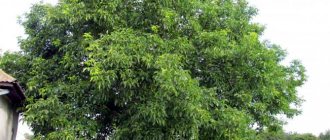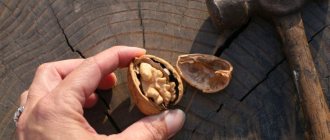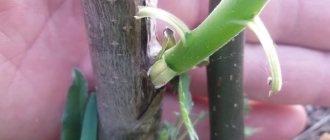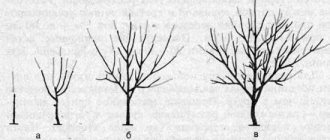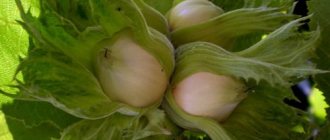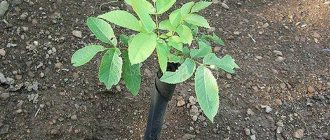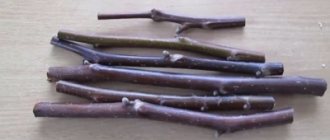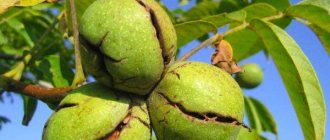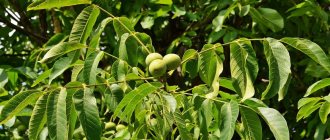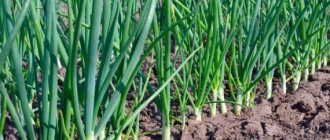Where to start
To grow a fruit tree from a whole nut at home, you need to carry out a preliminary selection from prepared planting material. The shell should be dense, and the outer skin should be easy to peel off. The largest seeds are best. In some cases, it is recommended to crack the shell, but there is a risk of damaging the nut kernel, and it must be completely preserved.
Stratification
Stratification is the holding of plant seed material at a certain temperature for accelerated germination. To prepare walnut fruits, you need to place them in moistened sand and keep them at a positive temperature of no higher than 5ºC. To comply with the conditions, you can place the vessel in the refrigerator or on a cellar shelf. The duration of stratification for nuts is from 3 to 4 months. Once every 20-30 days you need to ventilate and moisten the sand. After this treatment, prepared planting material can be planted directly into the ground.
Preparing for sowing
To speed up the germination of the nut, you can peel it from its dense shell - carefully split it and remove it. The procedure is not mandatory, but can speed up the emergence of seedlings. It is recommended to soak the kernels, after removing the shell or without such an event, in a bucket of warm water for 12-24 hours. It is better not to use fruits that will float on the surface as planting material.
Depending on the period of planting in the ground, further measures differ slightly. In the autumn season, you can simply put the nuts in the holes and bury them - shoots should appear in the spring. When planting after winter, it is recommended to warm the nuts in the sun (1-2 days), and then dry them in the shade. Planting material should not be placed near heating devices - there is a risk of overheating of the nucleoli and death of the embryos.
Landing in the ground
Before planting walnut fruits in open ground, holes are prepared in a selected area with a depth of about 15-20 cm. 3 to 4 fruits are placed in each hole. When digging, be sure to divide the soil into surface and deep. The top layer, when burying nuts, is poured onto the bottom. Additionally, it can be diluted with rotted compost. In the case of planting in greenhouse conditions, when the seedlings are ready, they are planted in a permanent place according to the following rules:
- The hole for the seedling must be designed according to the root system - the plant must be free.
- The central part of the root is cut off to actively form secondary lateral roots.
- The tree trunk must be tied to 3 pegs stuck around it with strong twine.
On a note!
At the planting site, to simplify watering, you can form a recess - this way all the water will be absorbed near the main part of the nut's root system.
Depending on its size, you need to pour from 5 to 10 liters of water under the young plant. But the amount of moisture must be strictly dosed - excess will lead to the death of planting material. In the autumn season, be sure to mulch the top layer of soil with sawdust, peat or chopped pine bark. For additional insulation for the winter, you can cover the tree and the root area of the earth with lutrasil or agrofibre.
How to grow walnuts from nuts at home
To successfully plant walnuts in the fall, choose a time before frost occurs. It is then that the ground is strewn with ripe kernels inside the shell. Be sure to select the best nuts from the fruit and then prepare them properly.
Once harvested, set aside the largest fruits for planting. Make sure their shell remains intact. Make sure that the green peel comes off easily, then the product is suitable for growing walnuts from it.
How to plant in the fall
You can plant and grow walnuts at home if you put the kernels along with the shells in late autumn before planting inside any container and fill them with water. It is better to throw away everything that floats up. But feel free to germinate the nuts that have sunk down for planting.
Planting walnut seeds is done in those parts of the site where the soil is moderately moist. It is not advisable to plant the plant if there is water close to the surface. At the same time, you should not try to plant the fruit near a bathhouse or other dacha building - if you grow a tree, it has strong roots that can destroy any foundation.
Loamy soil is better suited for planting a walnut tree at home. It is advisable to fertilize it using humus for compost or using walnut leaves as fertilizer.
First you need to dig a deep hole (at least a meter). Prepare the excavated soil before planting the walnut. The following supplements are recommended:
- fresh manure - a bucket;
- humus - 0.5 buckets ();
- a glass of ash;
- superphosphate - 100 g.
After mixing, you need to pour the prepared mixture down the hole. Afterwards, there is no need to feed the soil, as this will only worsen the fertility of the tree.
Now let's look at what depth is needed to plant a walnut. Make a shallow hole in soft soil (up to 15 cm). When planting, you cannot place the fruit so that its tip points upward, otherwise trees planted from nuts will begin to bear fruit later. Place the shell flat. It is recommended to plant 4 fruits together at the same time in order to select the strongest seedling after germination.
It is recommended to plant the nut in a pot first. It is also better to start this procedure closer to winter. Prepare a tub with drainage holes. At first, a pot with a diameter of 25 cm is suitable for germination. After 3 years, it will have to be transplanted into another container with larger dimensions.
Walnut care
Subsequent care for walnuts is minimal
It is only advisable to pay close attention to sufficient watering. This procedure cannot be repeated often
The best option is watering twice a month. The volume of water for each square meter of planting is 5 buckets. Although it is quite acceptable to water a growing seedling more often. If you take care of it like this, it will begin to grow faster. However, then it will become much more difficult for him to endure frosts in winter.
After the tree has sprouted, it needs to be fed periodically. Let's figure out how to feed walnut trees and how often to repeat this procedure. It is advisable to apply nutrients twice a year.
To increase fertility, “spring” nitrogen fertilizers are needed. In the fall, add substances with various minerals. Seedlings should be fertilized according to the instructions, otherwise it is easy to damage the root system with aggressive preparations.
Walnut trimming
To prevent excessive branch growth, learn how to properly prune your tree's crown. It is recommended to develop it for 3 years. It is advisable to prune a walnut by the second year of its life. When shaping, be sure to remove too thin, dry, and all old branches. It is advisable to prune walnuts in the fall, as well as before buds open.
Rules for planting seeds
Growing a walnut from its own fruit is painstaking work that requires not so much effort as time. At the same time, watching how a young tree grows is a rather interesting process. The first step is to properly prepare the material. For seeds, it is advisable to take only nuts freshly harvested in the fall with a thin shell and a tasty kernel. The shell must be free of stains, damage and other defects.
The fruits must be peeled in such a way as to separate only the upper shell: the internal membranes and seeds must remain. Place the nuts in a bucket of water and then select only the ones that sink for planting. Prepare a container with wet sand, plant the fruits in it to a depth of 1.5–2 cm and place in a cool place. Stratification of seeds should last about 4 months at a temperature of +1...+4°C, so the best storage for seedlings during this time will be a refrigerator or cellar. Once every 3 weeks you need to moisten the planting.
Did you know? In ancient times, people believed that eating walnut kernels improved mental abilities.
Commoners were forbidden to eat them, explaining that they did not need the ability to think.
In February or early March, nuts are planted - they are removed from the sand and transplanted into large separate containers (pots, 5-liter plastic bottles) filled with garden soil. The nuts should be laid flat, in a horizontal position. The kernels are planted to a depth of about 5 cm and watered abundantly. After 2-3 weeks, the first sprouts will appear and germinate quickly - after a month their height will already reach 15 cm. For another 2 months, the seedlings should be kept at home, regularly watering the soil. Walnut seedlings should be transplanted into open ground at the end of May. By this time it will reach a height of about 25 cm and will be quite strong.
Planting a nut directly into the ground
If you do not want to bother yourself with preliminary cultivation of seedlings in separate containers, you can plant the nuts in open ground immediately after harvesting. But it is worth considering that they will germinate much more slowly, so it is recommended to treat the seeds before planting in the Zircon growth stimulator. The advantage of planting directly into the ground is that the seedling will not need to be replanted in the future, which means there is no risk of damage to the root system.
We recommend that you learn about the peculiarities of growing walnuts in central Russia, Siberia and the Moscow region.
For landing:
- Dig a hole up to 1 m deep.
- The soil must be fertilized: mix it with 1 bucket of fresh manure, 80 g of superphosphate and a glass of ash.
- Pour the fertilized soil back into the hole, then make a hole in it 15–20 cm deep.
- Pre-moisten the soil.
- The nut, peeled from the top shell, is placed for germination in a horizontal position or sideways, on the edge, and covered.
- Once again you need to water the planting well (5–7 liters per hole).
If you plan to germinate nuts in the spring, the seeds should be stored in a cool place and stratified 3 months before planting (how to do this is described above). It is recommended to graft annual seedlings using a cutting with a bud, cut from an adult, high-yielding walnut tree. The grafting is done in mid-summer, when the plants have particularly active sap flow.
How to choose a fruit for planting
The type of walnut you choose for planting will determine whether your venture will be successful. In order for a tree to grow from a fruit, it must not be subjected to heat treatment or drying. Unfortunately, these are the products that most often go on sale, but towards the end of September you can find fresh crops in stores that can actually germinate.
You need to choose well-ripened, large specimens without any external damage. It should be borne in mind that any variety of walnut can be grown in a pot on the windowsill, and it will delight your eye all year round, performing a purely decorative function.
However, if you want to grow a real fruit-bearing nut tree in your garden, it is better to give preference to varieties that are suitable for your region of residence. Those varieties that are designed for the southern regions simply will not withstand the conditions of central Russia, and vice versa, their northern counterparts may die in too hot and dry a climate.
If you doubt whether it is possible to plant a walnut tree on your plot, buy the fruits of a fresh harvest (or better yet, if possible, pick them yourself from the tree) and plant them following simple instructions.
Stratification
To prepare nuts for sowing, place them in a suitable-sized container, sprinkle with damp sand and put them in a cool place. Storage temperature should be from zero to +5 degrees; a cellar or shelf in the refrigerator is best. Once every 3-4 weeks, take out the dishes, ventilate and moisten the sand. In total, stratification should last 3-4 months.
After this, the seeds can be removed from the sand and transplanted into open ground.
Pre-sowing preparation
For faster germination, it is better to remove the pericarp from the nuts. This is an optional procedure, but after it the sprouts appear earlier and are healthier. When cleaning, be careful not to damage the inner shell; an injured nut may not germinate or may develop into a diseased plant.
After this, soak the fruits in a bucket of water. For planting, select those that have sunk to the bottom - the kernel of such a nut is more likely to produce good shoots.
Further preparation depends on the time of planting. If you plant seeds in the spring, in April, you must first dry them in the sun for 1-2 days, and then dry them in the shade. Do not place kernels near heating devices under any circumstances! If planting is done in the fall, there is no need for drying; the sprouts will calmly sprout next spring in May.
Choosing a landing site
Walnuts have a very powerful root system, so it is best to plant them in moderately moist soil. High groundwater levels or close proximity to a garden house (or bathhouse) will not be beneficial, since the roots of an overgrown plant can damage the foundation. It is better to give preference to loamy soils, if necessary, strengthening the fertile layer with fertilizers. To do this, dig a hole about a meter deep, mix the soil with a large amount of manure, add a couple of glasses of ash and fill it back. In the future, the walnut needs little feeding; on the contrary, this can reduce its winter hardiness.
Landing in the ground
The seeds sink into holes up to 15-20 cm deep. Under no circumstances place the nut with the point up, because this way the future tree will begin to bear fruit much later. It would be correct to place it flat. 3-4 fruits are placed in one hole, from which the strongest sprout is subsequently selected.
Watering seedlings and young trees
A sufficient amount of water for walnuts will be 4 buckets per 1 square meter. meter about twice a month. You can water more abundantly, then the tree will grow faster, but with such care it will be more difficult for it to endure the winter.
It will not begin to bear fruit immediately - for 7-15 years, depending on the variety, but will delight you with the harvest for a long time, because an adult tree can live up to three hundred years.
Planting a plant in the ground
When replanting a nut to a permanent place in open ground, the main thing is to choose a suitable site and prepare a planting hole, having previously fertilized the soil composition. The survival rate of the plant will depend on how responsibly you take these steps. Transplant time is spring or autumn, but the second option is considered more preferable.
Important! In the afternoon, the activity of biological processes in the nut decreases, so it is recommended to replant the plant in the late afternoon.
Selecting a location
When planting a nut, it is very important to choose the right site. It should be noted that over time, a small tree will turn into a giant with a powerful root system and a lush crown, and therefore will require quite a lot of space
It is undesirable to plant nuts near buildings - they will interfere with the normal development of roots. For walnuts, it is better to select a spacious area that will be sufficiently illuminated by sunlight - this way the plant will bear fruit well, and fungal infections will not be able to multiply on it.
Pay attention to the soil moisture - it should not be swampy. Walnut loves moisture, but within reasonable limits
If groundwater lies close to the surface in the area, during planting it will be necessary to build a drainage layer so that the roots do not rot.
Soil preparation
The soil for planting deserves special attention. In order for the nut to take root well, it needs to be fertilized. Applying proper fertilizing will provide the tree with useful substances for the next few years. To make a nutritious cushion for a nut, you need to mix part of the natural soil with 2 kg of superphosphate and 500 g of potassium chloride. Add here 3–5 kg of compost and humus and a couple of kilograms of wood ash. The mixture of soil and fertilizer should be mixed well.
If the soil has high acidity, which can be determined by a special device or by the presence of a white coating on the surface of the earth, it must be limed by adding 400–500 g of dolomite flour per planting
Planting pit
The planting site is prepared in advance, before the seedling is taken from its previous place of growth, otherwise there is a risk that the rhizome will dry out. The planting hole should have a depth and diameter of about half a meter. The bottom is covered with a drainage layer of crushed stone, crushed brick, gravel or other material, the thickness of which is 10–15 cm. Next, you should pour several shovels of prepared fertilized soil.
Did you know? The name walnuts stuck in Russia due to the fact that the first large deliveries of the fruit were from Greece.
A day before transplanting, the young tree needs to be watered abundantly. When digging, you need to keep a moist ball of earth around the rhizome. If the central root is quite long, it is advisable to shorten it so that the length is no more than 30–35 cm - this way the nut will develop well in the future.
Video: Proper planting of walnuts
Planting process:
- The seedling is placed in the center of the hole and fertile soil is added up to half its height.
- The tree is watered, using about 10 liters of water, the remaining soil is added, lightly compacted and watered again with the same amount of water.
- You need to dig 3-4 wooden stakes on several sides of the planting hole and tie the seedling to them.
- The final stage is mulching the soil around the trunk. The layer of sawdust, humus or compost should not come into direct contact with the trunk to prevent the crown from rotting. The thickness of the mulch should be no more than 10 cm - this will help preserve soil moisture, which is essential for the nut after planting.
Why is it so important to fertilize the plant?
Unlike garden or field crops, few people feed trees.
Many people sincerely believe that fruit trees, including nuts, will take everything they need from the soil themselves.
This opinion is deeply wrong:
- The walnut has a very powerful root system, spreading wide and deep - but it can only take from the soil what it already contains. If the soil is too poor in nutrients, the nut will grow slowly and will not bear fruit.
- Proper feeding helps balance the development of the tree. Sometimes it happens, for example, that seedlings planted in nitrogen-rich soil (for example, where there was a compost heap a couple of years ago) shoot up sharply and can be broken by the wind. In this case, they need to be strengthened with supports - and the dose of potassium and phosphorus in the soil must be increased many times over.
- Fertilizing can increase the plant's resistance to harmful factors. For example, ammonium sulfate makes the nut less susceptible to damage from the codling moth. Correctly applied fertilizers in the first year will strengthen the wood and allow it to ripen better for winter - and this will allow the nut not to freeze in frosts.
- Trees used for commercial growing of nuts spend nutrients on fruit formation - and they need to compensate for this deficiency. Without this, good harvests will not last long - which is a shame: normally, a healthy tree bears fruit for at least 70-80 years.
How to feed a walnut tree
All fertilizers can be divided into two groups:
- organic - manure, compost (rotten leaves, tops, etc.), wood ash. Some plants - clover, alfalfa, oats, barley - enrich the soil with nitrogen, calcium, and sugars. To feed the walnut tree, they are grown next to the tree, and in the fall they are buried (plowed) into the soil;
- mineral - based on manganese, nitrogen, boron, magnesium, etc. More often they choose mixed ones, in which several minerals are present.
Important! It is not recommended to use organic and mineral fertilizers at the same time; they need to be alternated. Fertilizers containing nitrogen should not be used during fruiting.
Botanists and agronomists offer various options for proportions.
- Richter – ammonium sulfate (60 g/sq. m), ammonium nitrate (35), superphosphate (80), potassium salt (15). The botanist suggests these proportions for thinned soil.
- Dorofeev – ammonium sulfate (30 g/sq.m), superphosphate (20), potassium salt (10).
Gardeners have empirically found that the cost of fertilizing does not have a decisive impact on the result. A number of amateur gardeners suggest using fertilizer for walnuts, prepared independently:
- water infusion of weeds with superphosphate. Nettle, wheatgrass, quinoa and even woodlice are suitable for the base. The grass is poured into any container with water with the addition of superphosphate at the rate of 50 grams per 10 liters. The container is covered with a film with holes necessary for ventilation. After a couple of weeks, the foam will disappear from the surface of the infusion, which means the feeding is ready. For irrigation, the resulting liquid is diluted with water until it turns light brown;
- an aqueous infusion based on eggshell powder. It is also infused for up to 14 days; powder from the shells of at least five eggs is used per liter of water;
- yeast feeding. A 100-gram pack of yeast needs to be diluted in ten liters of warm water;
- leaves of the walnut tree itself. You can make compost from them, bury them in a circle around the tree trunk, burn them and sprinkle them with ash.
What fertilizer is used depends on the type and composition of the soil. Acidic soil “loves” nitrate fertilizers. Slightly acidic responds well to ammonium-nitrate fertilizing. Alkaline ones are fertilized with amide or ammonium compounds. Organic fertilizer is suitable for clay and sand. Podzolic soil requires lime, and peat soil requires potassium and phosphorus.
Fertilizing walnuts in autumn
Autumn feeding is important even in a favorable climate. For chernozem soil, fertilizer is applied with organic matter in the form of mulch or humus once every four years. In temperate climates - annually. The type depends on the time of the fertilization procedure. Before leaf fall, humus is used, which is lightly dug into the soil. The required amount is 3-6 grams per square meter. The number of square meters is calculated by eye along the perimeter of the crown; precise measurements are not required. After the leaves fall, mulching is carried out. Walnut growers believe that it is better not to “feed” the tree in order to avoid harm to the plant.
in spring
In the spring, it is necessary to fertilize the soil when it is thinning, in a temperate climate, or when the seedlings are lagging behind in development. How to feed walnuts in spring? Frosty climate and poor soil require annual feeding, sometimes double. The first step is to apply nitrogen-type fertilizers. They scatter on the slightly thawed ground. After three weeks, a complex of minerals is introduced into the groove of the tree trunk circle. After which the application site is spilled. The dosage of fertilizing is indicated in the instructions.
In summer
Summer feeding is carried out when the plant lags behind in development. It is held in the last ten days of summer or early September. A healthy plant cannot be fertilized in the summer; the ovaries may fall off and the yield will decrease. Superphosphate and potassium salt are added. Proportions – 25/15. This feeding will help a weak tree survive the winter.
How to tell from a tree whether it needs nutrients
When choosing what to feed a young walnut, they focus on ingredients that allow the plant to prepare for winter. If the nuts are grown for sale, it is especially important to give the tree as many nutrients as possible. A healthy tree can produce crops for 70 years, and therefore generate income.
Oversupply
A clear sign of an excess of nitrogen in the soil is excessive growth of greenery. If a tree is actively growing shoots and small branches, this is fraught with problems. Firstly, unripened wood is quite fragile, and the crown can break off under its own weight. Secondly, the growth of greenery comes at the expense of the formation of ovaries, so the harvest will be meager or nuts will not form at all. To avoid problems, sanitary pruning is carried out - the bark is cut so as to limit the access of nitrogen to some parts of the tree. The cut areas must be treated with varnish, otherwise infection may occur.
Flaw
A signal that it is time to feed the walnut is yellowing of the foliage, stunting of growth and death of shoots. Most often, such symptoms appear when grown on sandy soil and gray soil - in this case, it is necessary to regularly enrich the soil with nutrients. If the tree grows on black soil, walnut fertilizers are used as needed.
Feeding rules
You need to fertilize walnuts in compliance with a number of rules:
- fertilizing is introduced into a special groove - the tree trunk circle. It is dug along the diameter of the crown and is used annually. Do not be afraid that the distance to the trunk and roots will be large. In those regions where walnut grows strongly, soil fertilization is not required. In the middle zone, due to weather conditions and soil composition, the nut does not grow, so applying fertilizer to the tree trunk circle is sufficient;
- Damage to the roots should be avoided;
- The composition of the feeding is selected depending on the stage of growth. The seedlings are planted in a hole filled with a mixture of humus, ash and superphosphate. This mixture will last for at least three years. Nitrogen compounds are necessary during the growing season. In late summer and autumn, the tree requires minerals;
- liquid formulations are more active;
- nitrogenous ones are introduced to a depth of 5 cm, mineral ones - 15 cm;
- “poor” soil requires regular nutrition. Breaks will affect yields;
- Chernozem soil does not require annual nutrition.
What fertilizers are used as top dressing?
Based on their origin, fertilizers are divided into 2 groups:
- organic – plant and animal residues;
- mineral – chemical elements of inorganic nature. They consist of salts, oxides, acids and other compounds.
Each of them has additional subgroups.
Organic
Walnut responds well to:
- manure is the most common and affordable option;
- compost - decomposed leaves, tops, household organic waste;
- humus - rotted manure;
- wood ash - the remainder of burnt wood and plant residues: firewood, straw, tops, pine needles, coal.
Organic matter is added once every 2-3 years at the rate of 3-4 kg per 1 m². It improves the structure of the soil and the absorption of other substances, and activates the activity of beneficial bacteria.
It is prohibited to simultaneously use organic and mineral compounds. The best way is alternation.
A positive result is observed when using green manure plants:
- spring oats and barley;
- winter wheat and rye;
- alfalfa;
- clover;
- ryegrass;
- fescue;
- lupine;
- peas;
- rapeseed;
- rape.
They are specially grown for subsequent embedding in the ground. They are rich:
In the spring, plants are planted between rows, and in the fall they are plowed into the ground.
The tree trunk circle is mulched with manure, sawdust, and mown grass. The coating prevents drying out and cracking of the soil, and restores fertility.
Mineral products
Nut crops are crops with specific nutritional requirements. They, more than others, need:
These elements should be contained in fertilizers for different types of nuts:
Per year the crop requires:
- 6 kg of ammonium nitrate;
- 10 kg of superphosphate;
- 3 kg of potassium salt;
- 10 kg ammonium sulfate.
Zinc and manganese sulfate are added at the rate of 2.5 g per 1 m².
Nitrogen substances are prohibited from being used during the fruiting period.
Complex fertilizers
Complex compositions contain 2 or more elements.
- nitroammophoska - nitrogen, phosphorus and potassium in different proportions depending on the type of fertilizer;
- nitrophoska – nitrogen, phosphorus, potassium;
- ammophos and diammophos - nitrogen, phosphorus.
Walnut care: growing, pruning, feeding and watering
Among the variety of the Nut family, the most common are the walnut variety and almonds. The latter are more demanding, therefore they are less often grown on the territory of our state due to climatic conditions. Walnuts are considered unpretentious, so caring for walnuts will not be a big burden for gardening enthusiasts. Care is quite simple, but the level of fruitfulness of the plant depends on it. Important aspects of cultivation are the period of spring and autumn, when walnuts are vulnerable to external factors.
Taking care of walnuts in spring
Walnuts need to be fertilized and pruned in the spring. It is better to shorten long or dried branches in May. At the beginning of spring, the tree is still filled with sap. Walnut pruning in spring is conventionally divided into stages:
1) in the first year of life, trim so that a small knot remains;
2) subsequent years of life - the sections are lubricated with garden solution.
Pruning shoots should be done carefully.
Autumn period for the plant
Special attention should be paid to caring for the plant in the fall. This period is full of procedures for preparing walnuts for wintering.
The root system of the tree is saturated with nutrients so that winter does not destroy it. Remember that before winter it is forbidden to fertilize the soil with nitrogen fertilizers; the ash of woody plants will cope with this task perfectly.
Pruning a plant in autumn is similar to spring; in addition, the representative of the flora independently copes with the task of thinning the crown, which significantly saves your time.
Walnuts do not thrive in waterlogged or compacted soil. The most suitable soil for it is carbonate-type loams, where the groundwater level is not high. It has been noticed that open access to sunlight creates a spreading and beautiful tree crown.
When planting or replanting, pay attention to the location of other representatives of the flora. The distance between the walnut and another tree must be at least 5 meters for the walnut root system to develop
The soil must contain a minimum set of nutrients. Organic fertilizers are suitable for feeding - manure and ash mixed with superphosphate. Walnuts are fertilized to stimulate the growth of lateral roots.
Reproduction is carried out in two ways:
The first method is preferable in the spring, when pre-selected walnut fruits were dried at room conditions. Seeds are planted in April, when the ground is already warmed to a temperature of +10 °C. The planting depth depends on the size of the fruit and ranges from 7-11 cm. This method is slow - you will receive seedlings suitable for planting walnuts only 5-7 years after planting the fruits.
The second method is used in a situation where it makes sense to preserve the positive properties of the mother tree. Rootstock seedlings are brought indoors at the beginning of winter so that by the time of grafting, around the end of February, they will sprout. Grafted shoots are planted in the ground at the end of spring, in May.
Features of feeding and watering
Walnuts are more moisture-loving trees than many might think. They need to be watered at least 2 times a month, and even more often under conditions of elevated temperatures. You need to pour about 3-4 buckets of water onto one plant. Mature trees whose height exceeds 4 m are moistened less frequently.
Tree feeding must be done at least 2 times a year. Nitrogenous substances are added to the soil in the spring, and potassium and phosphorus substances are added before wintering.
It is important to refrain from adding chemical components during the first 2-3 years of fruiting
https://superorehi.ru/gretskie-orehi/kak-obrezat-gretskij-orehhttps://ogorod-bez-hlopot.ru/posadka-orexa-greckogo-osenyu.html
How to properly feed a plant
To summarize, we can give the following recommendations for feeding walnuts:
- On chernozem, the crop does not need regular fertilizing after the start of fruiting. Once every 4 years, the tree trunk circle is mulched in the fall with humus at the rate of 3-4 kg per square meter of crown projection onto the ground.
- Intensive feeding of walnuts growing on fertile black soil can harm the tree.
- Poor soils require two spring feedings. The first is done before the soil completely thaws with nitrogen fertilizers, the second - after about 3 weeks with a full mineral complex.
- Fertilizers should not be applied over the entire area of the tree trunk circle, but into a pre-dug groove, the diameter of which coincides with the size of the crown, mixed with soil and watered abundantly.
- There is no need to feed walnuts in summer unless absolutely necessary.
- Conducted at the end of summer, and in the south - at the beginning of autumn, fertilizers are classified as autumn. They are made exclusively with phosphorus and potassium (without nitrogen).
- In cool regions and poor soils, late-autumn mulching of the trunk circle with humus can be carried out annually.
Landing in the ground
The seedling should be transplanted to a permanent place in open ground when it has sprouted at home for a year and the trunk has grown 20 cm in height. It is better to plan planting in the spring - April - May.
If the option is chosen when the seeds are placed directly in the ground, then they are planted in the fall, in October, and less often in the spring, in April. In order for the planting to be successful, and for the tree to be healthy and pleased with stable harvests, you should choose a good location, prepare a planting hole and follow the technology of planting in open ground.
Selecting a location
For normal growth and development of a walnut, it needs warmth, light and a large area.
It is important that the area where you plan to grow this tree is well lit and no shadow should fall on it. The planting pit should be at a distance of at least 5–6 m from buildings and other plants
Before planting, you should check the groundwater level. The nut will not be able to grow if they are located closer than 1.5 m from the ground surface. As for the soil, the walnut tree grows well on loamy soils and in chernozems with neutral or low acidity levels.
Important! You can plant berry bushes near the nut. Before the tree reaches a large size, they will have time to produce 6–9 harvests of berries.
Soil preparation
When planting in spring, preparing the soil and digging the planting hole occurs in the fall. The area is thoroughly cleared of plant debris and dug up using a shovel.
If the nut is planted in the fall, then preparatory work begins several weeks before planting. The soil extracted when digging a hole is mixed with manure (1 bucket), superphosphate (1 tbsp.), wood ash (2 tbsp.).
Advice from professionals
It is better to slightly underfeed the tree than to overdo it with nutrients.
Experienced gardeners give the following advice:
- Walnuts native to temperate climates do not produce annual or record fruiting rates.
- On infertile soils, it is necessary to adhere to the fertilizing schedule. If there is an excess of fertilizers, the nuts fall off and the growth and development of the crop is disrupted. If there is a lack of nutrients, young trees do not tolerate frost well and bear little fruit.
- The crop grown on black soil does not require additional feeding.
The mulch around the trunk must be checked regularly to ensure it is free of pests and parasites.
